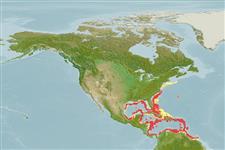Common names from other countries
Classification / Names / Names
Common names | Synonyms | Catalog of Fishes (gen., sp.) | ITIS | CoL | WoRMS
Environment: milieu / climate zone / depth range / distribution range
Ecology
Benthic; depth range 130 - 830 m (Ref. 271), usually 200 - 600 m (Ref. 4). Tropical; 42°N - 6°N, 97°W - 53°W (Ref. 4)
Western Atlantic: from USA and Bermuda to French Guiana and Suriname, including the entire Gulf of Mexico and Caribbean Sea.
Length at first maturity / Size / Weight / Age
Maturity: Lm ? range ? - ? cm Max length : 14.5 cm TL male/unsexed; (Ref. 4)
Carapace length: 1.5 to 7 cm (Ref. 39). Deep sea (Ref. 97531).
Life cycle and mating behavior
Maturity | Reproduction | Spawning | Eggs | Fecundity | Larvae
Members of the order Decapoda are mostly gonochoric. Mating behavior: Precopulatory courtship ritual is common (through olfactory and tactile cues); usually indirect sperm transfer.
Holthuis, L.B. 1991. (Ref. 4)
IUCN Red List Status (Ref. 130435)
CITES status (Ref. 108899)
Not Evaluated
Not Evaluated
Human uses
Fisheries: of potential interest
| FishSource |
Tools
More information
Age/Size
Growth
Length-weight
Length-length
Morphology
Larvae
Abundance
Internet sources
Estimates based on models
Preferred temperature
(Ref.
115969): 8.1 - 19.4, mean 13 (based on 187 cells).
Vulnerability
Low vulnerability (10 of 100).
Price category
Unknown.
